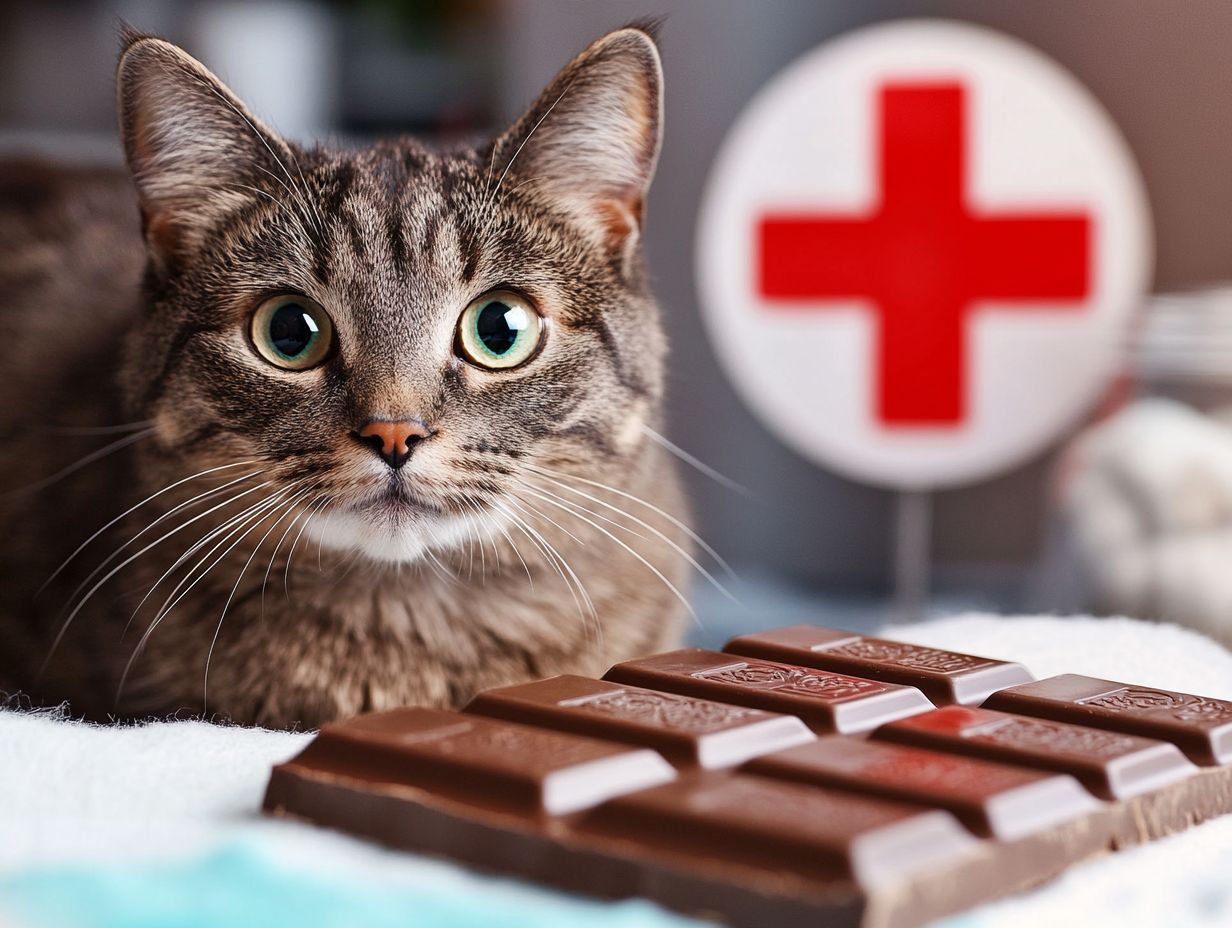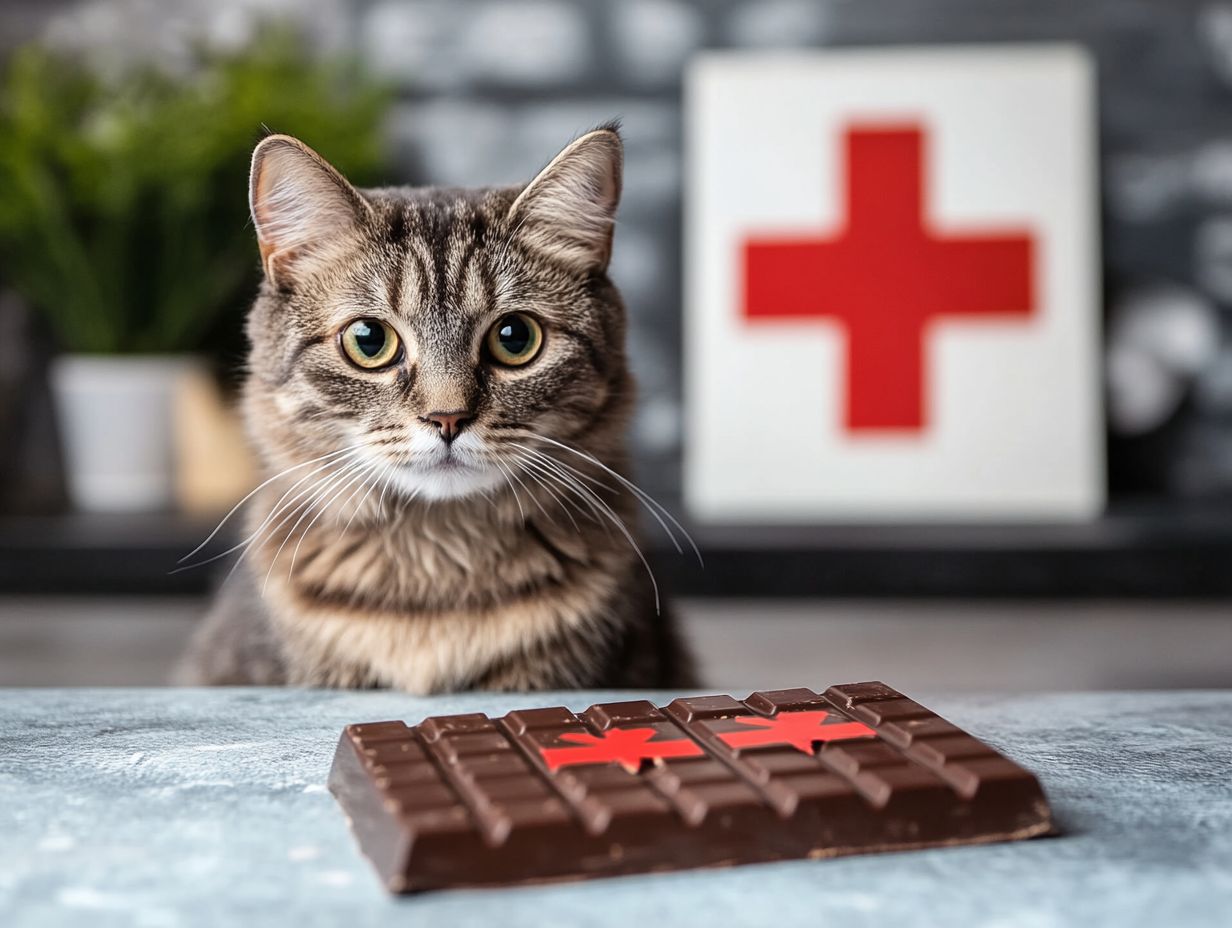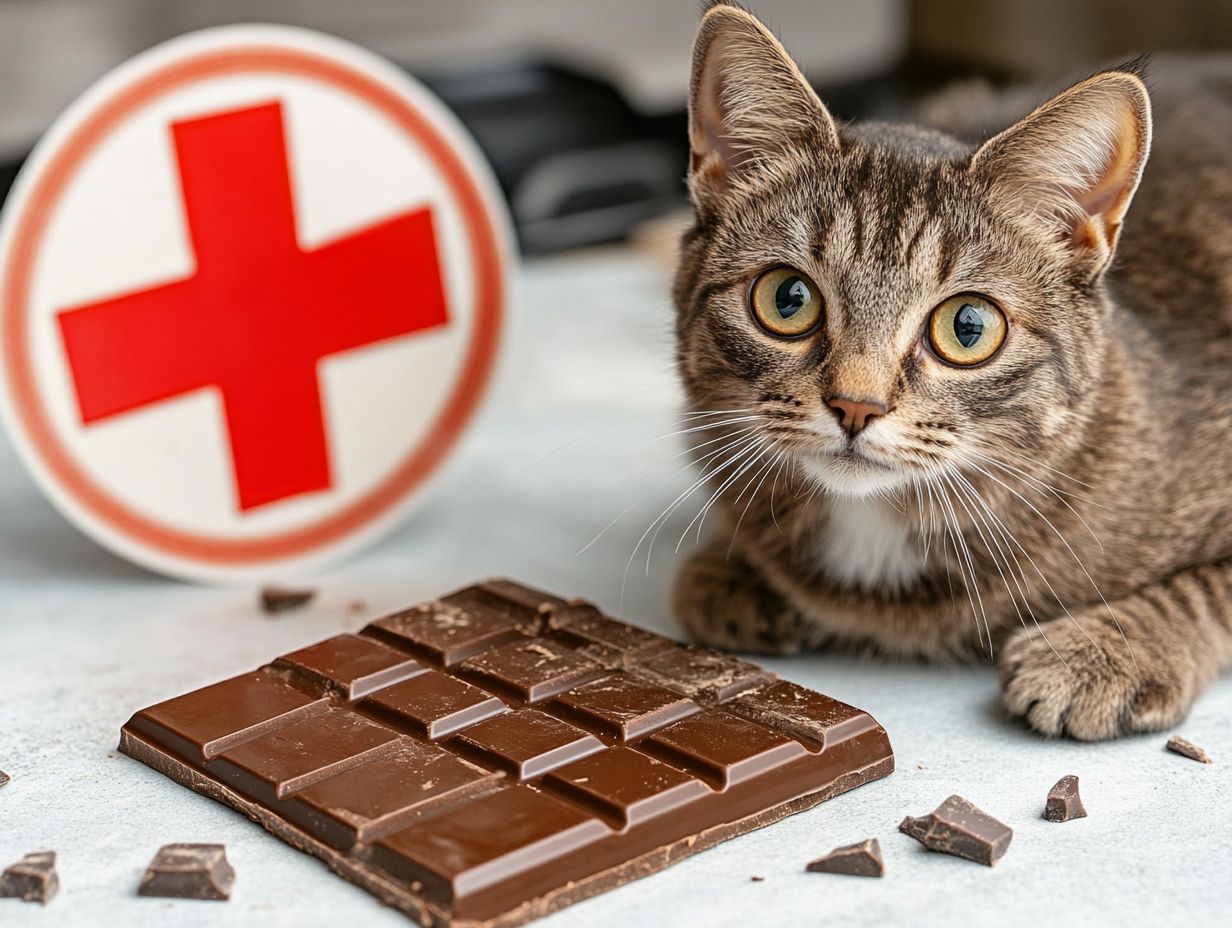Chocolate is a delightful treat for humans, but for your cat, it can be a deadly poison. Understanding the risks associated with chocolate consumption is essential for every cat owner.
Chocolate might be a beloved indulgence for many, but it poses serious health risks for our feline companions, including breeds like Russian Blues. With its toxic components such as caffeine and theobromine, chocolate can lead to severe health issues in cats, making it crucial for pet owners to understand the dangers of chocolate ingestion.
This article explores the symptoms of chocolate poisoning, effective treatments, and preventative measures to keep your cat safe from chocolate toxicity. It also offers some tasty alternatives to chocolate treats that your furry companion will enjoy. Keep reading to safeguard your pet and ensure food safety!
Key Takeaways:

- Chocolate contains toxic components that can be harmful and even fatal for cats, such as caffeine and theobromine, making chocolate products dangerous for feline health.
- Symptoms of chocolate poisoning in cats include vomiting, diarrhea, and increased heart rate. Symptoms may appear within 2 to 12 hours after ingestion. Look out for these signs and seek veterinary help immediately if you suspect your cat has ingested chocolate.
- In case of chocolate poisoning, it is important to act quickly and seek professional treatment. Inducing vomiting or giving activated charcoal can help prevent absorption of the toxins in chocolate.
Why Chocolate is Harmful for Cats
Chocolate is a food that many people enjoy, but for your cat, its consumption poses severe health risks. The toxic components of chocolate, specifically caffeine and theobromine, are particularly dangerous for our feline companions. Even small amounts can lead to chocolate poisoning in cats, resulting in side effects that can be fatal and necessitate immediate veterinary attention. Cat owners must be aware of the dangers associated with chocolate ingestion, as the effects on feline health can be grave and potentially life-threatening.
The Toxic Components of Chocolate
Chocolate is toxic to cats due to the presence of theobromine and caffeine, both of which can lead to serious health issues. When ingested, these substances can cause arrhythmias, tachycardia, and potentially even central nervous system problems. The level of toxicity varies significantly depending on the type of chocolate consumed, with darker chocolates—such as baking chocolate and chocolate bars—being more than ten times higher in theobromine concentration than milk chocolate. Even chocolate-flavored foods like ice cream can pose a risk, albeit at a lower concentration. To keep their pets safe, owners should ensure that all chocolate-containing products are placed out of reach and contact a veterinarian immediately if ingestion occurs for guidance.
Symptoms of Chocolate Poisoning in Cats
Understanding the symptoms of chocolate poisoning in cats is crucial for prompt intervention and treatment. Pet owners should be vigilant for signs such as vomiting, rapid heart rate, restlessness, and, in severe cases, seizures after a cat has ingested chocolate, as these indicate a serious health risk. Symptoms may manifest anywhere from a couple of hours to a full day after ingestion, so early detection is vital. This awareness is essential to ensure that the cat receives timely emergency veterinary care, which can potentially save its life.
Signs to Look Out For

Early detection of chocolate poisoning in cats is crucial. Owners should be aware of the most common signs of chocolate toxicity, as recognizing these symptoms can facilitate faster veterinary intervention. Common signs of chocolate poisoning in cats include:
- Restlessness
- Erratic heart rate
- Muscle tremors
- Excessive drooling
- Gastrointestinal disturbances such as vomiting and diarrhea
Additionally, behavioral abnormalities like increased anxiety or disorientation may indicate distress related to chocolate poisoning. It is essential for owners to monitor their cats closely, as early recognition of these symptoms can significantly improve the chances of successful treatment and recovery. Proactive health management can make a significant difference in pet safety and overall pet health.
Treatment for Chocolate Poisoning in Cats
Yes, a cat can be treated for chocolate poisoning. The best chance for recovery occurs when a cat receives veterinary treatment as soon as possible.
In conclusion, chocolate can be a deadly poison for cats, and it is imperative for pet owners to keep chocolate out of reach and educate themselves about other foods that may be toxic to their feline companions. Always consult a veterinarian immediately if you suspect your cat has ingested chocolate.
What should you do if your cat eats chocolate? Important components of the treatment include inducing vomiting or giving activated charcoal to minimize the absorption of theobromine or caffeine from the gastrointestinal tract, ensuring effective care. Even small amounts of chocolate can be harmful to cats, so quick action is essential.
The availability of emergency veterinary services for treating any type of poisoning ensures that pet owners can quickly obtain the necessary care for their cats.
What to Do in Case of Poisoning
If your cat consumes chocolate, you can reduce the risk of poisoning by responding quickly and appropriately. First, remain calm and try to gather important information, including the type of chocolate eaten (e.g., dark chocolate, baking chocolate), the amount consumed, and the time of ingestion. This information will assist veterinary professionals in determining the best course of treatment.
The next step is to contact an emergency veterinarian as soon as possible; be prepared to provide details about your cat’s weight, medical history, and any symptoms, such as vomiting or lethargy, that it may be displaying to get the right treatment. Only a veterinarian should determine dosages for activated charcoal based on your cat’s weight.
The sooner you obtain veterinary advice, the better the chances of a positive outcome and effective medical care for your cat.
Preventing Chocolate Poisoning in Cats
Preventing chocolate poisoning is the best way to ensure the health and safety of cats. Pet owners can protect their pets by understanding the risks associated with chocolate, keeping chocolate products out of reach, and creating safe environments within their homes.
By being mindful of the types of foods stored at home, owners can significantly reduce the likelihood of their cats consuming chocolate.
Tips for Keeping Your Cat Safe
- Educate yourself about the types of foods that can be harmful.
- Opt for healthier and safer cat treats instead of commercial foods that may contain chocolate ingredients.
- Carefully read labels to avoid any chocolate hazards.
- During holidays like Easter or Halloween, ensure that chocolate items are kept out of reach.
- Educate family members about the dangers of chocolate for cats to reinforce pet health and safety within your home.
Alternatives to Chocolate for Cats
Safe food options for cats, as alternatives to chocolate, include a variety of snacks and treats that do not compromise their health. These options consist of specially formulated cat treats as well as safe human foods, such as cooked meat and fish, which can provide similar taste experiences.
By selecting the appropriate snacks, pet parents can offer their cats enjoyable treats while ensuring their overall well-being.
Safe Treats and Snacks for Cats
The best treats and snacks for your cat are those that prioritize safety and nutrition, contributing to their overall health and well-being. Today, there is a wide variety of both commercial and homemade products available in stores and online, making it essential to select options that are healthy and safe for your cat.
For instance, freeze-dried chicken or fish treats are an excellent source of protein, satisfying a cat’s natural hunting instincts while promoting muscle growth and development. Additionally, small pieces of cooked pumpkin can provide fiber, aiding digestion and reducing the likelihood of hairballs.
Always check the ingredient labels, as some products may contain fillers and artificial additives that could be harmful to your cat’s health. Healthy cat treats not only offer a way to reward your feline friend but are also vital for maintaining their overall health. For more information on potential dangers, read about Can Cats Eat Chocolate? Risks and Dangers Explained.
Frequently Asked Questions
Can cats eat chocolate?

No, cats should not eat chocolate. It can be toxic and harmful to their health, leading to serious conditions like coma or seizures.
What makes chocolate dangerous for cats?
Chocolate is a beloved treat for many humans, but it poses serious health risks to cats. Understanding these dangers, as well as how to respond in case of accidental consumption, is crucial for every cat owner. Chocolate contains theobromine and caffeine, which are toxic to cats and can lead to various health issues, so keeping chocolate away from your cat is essential.
Why is it important to know about chocolate toxicity?
Knowing the dangers of chocolate helps cat owners take preventive measures to protect their pets.
What are the risks of cats consuming chocolate?
The risks of cats consuming chocolate include:
- Vomiting
- Diarrhea
- Increased heart rate
- Tremors
- Seizures
- Death
What types of chocolate are the most dangerous for cats?
All types of chocolate can be toxic to cats, but dark chocolate and baking chocolate have higher levels of theobromine and caffeine, making them more dangerous. Common products to avoid include dark chocolate bars and baking chocolate.
What should I do if my cat eats chocolate?
If your cat has consumed chocolate, follow these steps:
- Contact your veterinarian immediately.
- Do not wait for symptoms to appear.
- Keep any packaging or pieces of chocolate to show your vet.
Is there any amount of chocolate that is safe for cats to eat?
No, even a small amount of chocolate can be toxic to cats. For example, while a tiny amount of chocolate might not cause immediate harm, the risk is not worth it. It’s best to keep all chocolate out of reach of cats to prevent any accidental ingestion, especially during holidays like Halloween.
Conclusion
In conclusion, chocolate is never safe for cats. Always keep chocolate out of reach and be vigilant during holidays when sweets are abundant. Understanding chocolate dangers for pets is vital for ensuring cat health. Share this information with other pet owners and consult your veterinarian for personalized advice on keeping your cat safe.